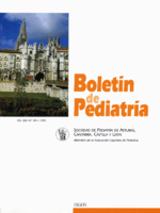Trasplante renal y crisis epilépticas en la infancia
M. Rufo-Campos , J. Fijo-López Viota , A. Sánchez-Moreno , A.M. Vázquez-Florido , M. Madruga Garrido , J. Martín Govantes
Bol. Pediatr. 2003; 43 (183): 19 - 26
La semiología clínica neurológica que puede presentarse en el contexto de un trasplante renal, comprende un amplio y variado abanico de enfermedades neurológicas. Y una gran parte de las complicaciones neurológicas del trasplante renal pueden desarrollar crisis convulsivas. Objetivo: Se pretende analizar la incidencia de las crisis convulsivas en niños que tras el diagnóstico de insuficiencia renal terminal han recibido un trasplante renal, estudiando las características semiológicas de los episodios convulsivos, su posterior evolución y la presencia de posibles secuelas. Se han relacionado los distintos factores desencadenantes de las crisis, con su evolución y con su tratamiento. Material y métodos: Durante un período de 20 años, se revisan de forma retrospectiva 42 pacientes que ingresados en el hospital han sido sometidos a un trasplante renal. El estudio informático de las 18 variables médicas recogidas se realiza con el programa SPSS versión 9.0.1. Resultados: Del total de enfermos, 13 habían sufrido algún tipo de crisis convulsiva (30,95%), con una edad media de aparición de la primera crisis de 69 meses. Como factor desencadenante, hubo un desequilibrio hidroelectrolítico en 8 casos, hipertensión en 2, y otras causas no bien determinadas en los restantes. sólo en 3 casos que correspondían a epilepsias previas al fallo renal, se mantenían las manifestaciones críticas. Abstract The neurological clinical semiology that can be presented in the context of a renal transplant, understands a wide and varied fan of neurological illnesses. And a great part of the neurological complications of the renal transplant can develop convulsive crisis. Objective: It is sought to analyze the incidence of the convulsive seizures in the renal transplant, studying the characteristic semiológics of the convulsive episodes, their later evolution and the presence of possible sequels. He has been related the different potential causes of the seizures, with their evolution and with their treatment. Material and methods: During a 20 year-old period, they are revised in way retrospective 42 patients entered in the hospital with the diagnosis of renal transplant. The computer study of the 18 steps medical collections is carried out with the program SPSS 9.0.1. Results: Of the total of sick, 13 had suffered some type of convulsive seizure (30.95%), with a half age of appearance of the first crisis of 69 months. As factor desencadenant, there was an imbalance hydroelectrolyte in 8 cases, hypertension in 2, and other causes as soon as determined in the remaining ones. Alone in 3 cases that corresponded to previous epilepsies to the renal failure, they stayed the critical manifestations. Comments: The epileptic seizures of the renal transplant in the childhood can be considered as occasional seizures that are not accustomed to cronic neither to leave deficit sequels. The handling of the seizures in the renal failure should be disclosed among the professionals that assist systemic illnesses.
\N
\N
Artículo completo (PDF) (43 kb.)
- Neurología
